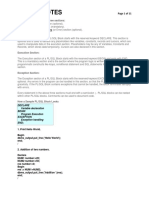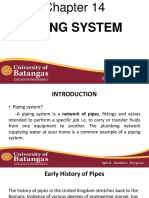Chapter-12 Getting Started With PL/SQL: SQL Vs PL/SQL: Limitations of SQL Are
Uploaded by
Archit GargChapter-12 Getting Started With PL/SQL: SQL Vs PL/SQL: Limitations of SQL Are
Uploaded by
Archit Gargwww.ncrtsolutions.
in
CHAPTER-12
GETTING STARTED WITH PL/SQL
SQL Vs PL/SQL:
Limitations of SQL are:
• No procedural capabilities .
• Time Consuming Processing or Network traffic.
• No Error Handling Routines/Procedures.
Advantages of PL/SQL are:
• Procedural Capabilities.
• Reduced Network Traffic.
• Error Handling Procedures/Routines.
• Facilitates Sharing.
• Improved Transaction Performance.
• Portable Code.
ANCHORED DECLARTION:
It refers to a declaration where a variable is declared with another variable or a table column used
as its anchor.
PL/SQL use %TYPE declaration attribute for anchoring.
Ex: num1 NUMBER(5);
num2 num1%TYPE;
empsal Emp.Salary%TYPE;
Note: Anchored types are evaluated at compile time.Thus,you need to recompile the change of
underlying type in the anchored variable.
TYPES OF PL/SQL VARIABLES:
• Local Variables.
• Substitution Variables.
• Bind or Host Variables.
PL/SQL BLOCK STRUCTURES:
DECLARE
/* definitions of <constants>
<variables>
BEGIN
<PL/SQL statement here>
[EXCEPTION]
<Exception Handling>
END;
Material Downloaded From http://www.ncrtsolutions.in
www.ncrtsolutions.in
TYPES OF BLOCKS:
• Anonymous Blocks: Blocks without headers.
• Named Blocks: Blocks having headers or labels like procedure,functions,packages or
triggers.
PL/SQL CONTROL STRUCTURES:
• Sequence
• Selection
• Iteration.
SELECTION CONSTRUCT: (Condition Testing or Decision Making Statements)
1. Simple IF:-
Syntax:
IF <condition>THEN
Statement
END IF;
Example:
DECLARE
a number;
BEGIN
a :=&a;
if a>100 THEN
dbms_output.put_line(a);
END IF;
2. IF…THEN…ELSE…END IF:-
Syntax:
IF <condition>THEN
Statement1;
ELSE
Statement2;
END IF;
Example:
DECLARE
a number;
b number;
BEGIN
a :=&a;
b :=&b;
if a>b THEN
dbms_output.put_line(a);
ELSE
dbms_output.put_line(b);
END IF;
Material Downloaded From http://www.ncrtsolutions.in
www.ncrtsolutions.in
3. NESTED IF ….ELSE:-
IF <condition>THEN
Statement1;
ELSIF <condition>
Statement2;
THEN
.
.
.
ELSE
END IF;
Example:
DECLARE
a number;
b number;
c number;
BEGIN
a :=&a;
b :=&b;
c :=&c;
if a>b THEN
if a>c THEN
dbms_output.put_line(a);
ELSE
dbms_output.put_line(c);
END IF;
ELSE
if (b>c) THEN
dbms_output.put_line(b);
ELSE
dbms_output.put_line(c);
END IF;
END IF:
4. ELSIF LADDER:-
Example:
DECLARE
salary number;
BEGIN
salary :=&salary;
if salary >=10000 THEN
dbms_output.put_line(“CLASS I OFFICER”);
ELSIF salary <10000 AND salary>=8000 THEN
dbms_output.put_line(“CLASS II OFFICER”);
ELSIF salary <8000 AND salary>=5000 THEN
dbms_output.put_line(“CLASS III OFFICER”);
ELSE
dbms_output.put_line(“YOU ARE NOT IN JOB”);
END IF;
END IF;
Material Downloaded From http://www.ncrtsolutions.in
www.ncrtsolutions.in
Points to remember for using IF:
• Always match up an IF with an END IF.
• You must put a space between the keywords END and IF.
• The ELSIF keyword does not have an embedded “E”.
• Place a semicolon (;) only after the END IF keywords.
ITERATION CONSTRUCT : (LOOPS)
PL/SQL provides three different types of loops:
• The simple loop.
• The FOR loop.
• The WHILE loop.
A General Loop Structure:
A loop has two parts: the loop boundary and the loop body.
The Simple Loop:
Syntax:
LOOP
<executable statement>
END LOOP;
Example:
DECLARE
n :=0;
LOOP
n:=n+1;
Dbms_output.put_line(n);
END LOOP;
NOTE: Simple loop does not terminate by itself.So EXIT and EXIT WHEN
statements are used with it to terminate the loop.
Ex: DECLARE
count number :=0;
BEGIN
LOOP
count :=count +1;
dbms_output.put_line(‘value of count is’||count);
IF count >=10 THEN
EXIT;
END IF;
END LOOP:
dbms_output.put_line(‘Hi,I m out of the loop’);
END;
Ex: DECLARE
count number :=0;
BEGIN
LOOP
count :=count +1;
dbms_output.put_line(‘value of count is’||count);
EXIT WHEN count>=10 ;
END LOOP:
dbms_output.put_line(‘Hi,I m out of the loop’);
END;
Material Downloaded From http://www.ncrtsolutions.in
www.ncrtsolutions.in
THE NUMERIC FOR LOOP:
The FOR LOOP provided by PL/SQL comes in two forms:
a) Numeric For loop.
b) Cursor For loop.
NUMERIC FOR LOOP:
Syntax:
FOR <loop index> IN [REVERSE] <lowest number>..<highest number>
LOOP
<executable statements>
END LOOP;
Ex:
BEGIN
FOR num IN 1..20
LOOP
n := num*2;
dbms_output.put_line(n);
END LOOP;
END;
Ex:
BEGIN
FOR num IN REVERSE 1..20
LOOP
n := num*2;
dbms_output.put_line(n);
END LOOP;
END;
Characteristics of Numeric For Loop:
a) Loop index is automatically declared.
b) Expressions in range scheme are evaluated only once.
c) Loop index is not modifiable.
THE WHILE LOOP:
Syntax:
WHILE <condition>
LOOP
<executable statement>
END LOOP:
NOTE: WHILE loop tests the condition before executing the loop.
Ex:
DECLARE
n number;
BEGIN
WHILE n<=10
LOOP
Material Downloaded From http://www.ncrtsolutions.in
www.ncrtsolutions.in
n := n+1;
dbms_output.put_line(n);
END LOOP;
END;
Variations of WHILE Loop:
WHILE TRUE
LOOP
<executable statement>
END LOOP;
The Nested Loops:
The nesting of loops or nested loops mean that a loop resides within another loop.
A loop can nest any type of loop.
Ex:
DECLARE
i number :=0;
BEGIN
WHILE i<10
LOOP
i :=i+1;
dbms_output.put_line(i);
END LOOP;
END;
LABELLING LOOPS:
Loops can be labeled to enhance readability.
Syntax:
<<outer loop>>
LOOP
.
.
EXIT WHEN condition;
END LOOP outer loop;
DATABASE INTERACTION IN PL/SQL:
We can use following SQL statements in PL/SQL code.
SELECT,INSERT,UPDATE,DELETE.
SELECT INTO statement:
This statement is used to store the resultant data of SELECT query into PL/SQL variables.
Syntax:
SELECT <select list> INTO <variable_list>
FROM <table>[WHERE <condition>];
The above syntax is used when we want to store some particular fields or columns of SQL into
PL/SQL variables.
Material Downloaded From http://www.ncrtsolutions.in
www.ncrtsolutions.in
But what if we wish to store entire row of data into PL/SQL variable, in that situation the concept
of records is used.
USING RECORDS:
A PL/SQL record is a group of multiple pieces of information,related to one another,called fields.
Types of Records:
a. Table based records.
b. Programmer based records.
c. Cursor based records.
Table based records:
It represents each field in the table. For this anchored declaration %ROWTYPE is used.
Syntax:
<record name> <table name>%ROWTYPE;
Programmer Defined Records:
It is an explicitly defined record in PL/SQL.It is defined with TYPE statement as per the following syntax.
Syntax:
TYPE <typename> IS RECORD (field_declaration[,field declaration]…);
Here,RECORD TYPE declared is treated as a data type,which can not hold values.For which we need to
declare a variable of that type.
Syntax:
Variablename RECORD type;
This variable can now be used to access individual columns or fields.
EXCEPTION HANDLING IN PL/SQL:
EXCEPTIONS are some unwanted or undesired situations,which terminate the PL/SQL script
unexpectedly.
Types Of EXCEPTIONS:
1. Predefined Exceptions.
2. Undefined Exceptions.
3. User-defined Exceptions.
Predefined Exceptions are not needed to be declared and raised while Userdefined Exceptions are to be
declared,raised and handled in EXCEPTION handling section.
***
Material Downloaded From http://www.ncrtsolutions.in
You might also like
- Ex - No: 6 Date:16.02.2019 Write A PL/SQL Block To Satisfy Some Conditions by Accepting Input From The UserNo ratings yetEx - No: 6 Date:16.02.2019 Write A PL/SQL Block To Satisfy Some Conditions by Accepting Input From The User8 pages
- Processing Queries With PL/SQL: Example 1-5No ratings yetProcessing Queries With PL/SQL: Example 1-55 pages
- Advanced SAS Interview Questions You'll Most Likely Be AskedFrom EverandAdvanced SAS Interview Questions You'll Most Likely Be AskedNo ratings yet
- BE EXPERT IN JAVA Part- 2: Learn Java programming and become expertFrom EverandBE EXPERT IN JAVA Part- 2: Learn Java programming and become expertNo ratings yet
- JASREP User's Manual For Ocean-Going Ships: 1 OutlinesNo ratings yetJASREP User's Manual For Ocean-Going Ships: 1 Outlines14 pages
- Define the Case Study 4 Terms (Bud Cash Fulton)No ratings yetDefine the Case Study 4 Terms (Bud Cash Fulton)2 pages
- Saint Louis College: College of Engineering and ArchitectureNo ratings yetSaint Louis College: College of Engineering and Architecture3 pages
- Complete Download Ideology Studies New Advances and Interpretations 1st Edition Michael Freeden PDF All Chapters100% (3)Complete Download Ideology Studies New Advances and Interpretations 1st Edition Michael Freeden PDF All Chapters40 pages
- Classic Chic_ Music, Fashion, and Modernism -- Mary E_ Davis -- California Studies in 20th-Century Music, 2006 -- University of California Press -- 9780520245426 -- 3f2d1d74792722447600cfea0acd2133 -- Anna’s ArchiveNo ratings yetClassic Chic_ Music, Fashion, and Modernism -- Mary E_ Davis -- California Studies in 20th-Century Music, 2006 -- University of California Press -- 9780520245426 -- 3f2d1d74792722447600cfea0acd2133 -- Anna’s Archive354 pages
- MKT309 (ENT309) EVENT MANAGEMENT SUMMARY 08024665051No ratings yetMKT309 (ENT309) EVENT MANAGEMENT SUMMARY 0802466505146 pages
- Chap1 Introduction To Information SecurityNo ratings yetChap1 Introduction To Information Security14 pages
- Achievement Test, Diagnostic Test, Achievements VsNo ratings yetAchievement Test, Diagnostic Test, Achievements Vs9 pages

























































































